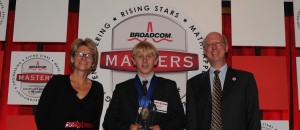Surf zone study earns young scientist first place
Top prizes awarded in Broadcom MASTERS science competition for middle schoolers
By Devin Powell

October 5, 2011. A version of this story was originally published in Science News
A typical 14-year-old goes to the beach to play in the waves. But Daniel Feeny went to a beach near Pescadero,Calif., to study them. Using a homemade rig of springs and balls set up in a tide pool, he showed that the force of the waves there doesn’t dictate the number of different plants and animals living close to shore.
“I discovered that nature doesn’t work that way, it’s not that simple,” says Feeny, who ran his experiment as an eighth-grader atWoodside Elementary School. “There are so many variables that can affect diversity, like the terrain and drying out.” Terrain refers to a piece of land or the physical features of it, such as what it’s made from.
For his original research and his performance in a series of team-based contests, Feeny has won first place in the inaugural Broadcom Math, Applied Science, Technology and Engineering for Rising Stars, or MASTERS, program. Winners and finalists in this national competition for sixth-, seventh- and eighth-graders were honored October 4 at a fancy celebration held at the Carnegie Institution for Science in Washington, D.C.
“It’s all about getting more kids to touch science and to have a hands-on experience with science,”, says Scott McGregor, chief executive officer of Broadcom Corp. and president of the Broadcom Foundation, which sponsors the competition. Feeny’s prize, a $25,000 education award, was funded by the Samueli Foundation, a private nonprofit organization based in Corona del Mar,Calif., begun by Broadcom’s cofounder Henry Samueli.
In its first year, the competition received 1,476 entries submitted by students from 45 states, Puerto Rico and Washington, D.C. Each student had been nominated by a local science fair affiliated with Society for Science & the Public, or SSP. SSP is a nonprofit organization that sponsors the Broadcom MASTERS program and publishes both Science News and Science News for Kids. Thirty finalists flew to the nation’s capital in October to present their research projects, meet with members of Congress and compete in contests. Those competitions tested their aptitude in science, technology, engineering and mathematics.
“We want to reinforce a scientific mindset in students whether or not they end up going into science,” says Elizabeth Marincola, president of SSP, which publishes Science News for Kids.
The international team of scientists and engineers that judged the students’ performances awarded second place and $10,000 to Benjamin Hylak, 14, of West Grove,Penn. Hylak had been inspired by a visit to his grandmother in a nursing home. He built and programmed a robot that can be operated remotely over the Internet for people who live far from their relatives.
“We’ve all run out of time in our culture, and I was seeing a lot of people staring at walls,” says Hylak, who made the robot out of a Roomba automated vacuum cleaner, a trash can and a total of $500 in parts.
Third place and a $5,000 award went to I-Chun Lin, 14, ofPlano,Texas. Lin studied cheap, easy-to-manufacture solar cells coated with organic dye. She tested new ways to increase their efficiency using natural dyes from raspberries and blackberries.
Other finalists earned a combined $20,000 in prizes for outstanding performances in individual disciplines. Fourteen-year-old Samantha Rowland of Tipp City, Ohio, took home the award for the science category. She counted Christmas tree needles to test whether some colors of decorative lights cause more needles to fall off than other colors Robert Heckman won in the technology category. The 14-year-old snorkeler from Hawaii had investigated why tumors form on corals. For her tests of whether higher salt concentrations have an impact on mudsnails, Katherine Landoni, 14, of Sequim,Wash., placed first in engineering. The math award recipient drew on her experience frosting cakes with her grandmother. Fourteen-year-old Crystal Poole ofSan Diego, showed that adding cornstarch helps prevent icing from melting.
Two competitors chosen for the Rising Stars award will travel to Pittsburgh in May to observe the Intel International Science and Engineering Fair. This competition organized by SSP brings together more than 1,500 high school students to present their research. Carolyn Jons, 13, of Eden Prairie,Minn., is one of these winners. She impressed judges by showing that bubbles can improve the insulation provided by a liquid. Chad Campbell, 12, of Hampstead, N.C., developed a way to test for antibiotics in meat samples from local supermarkets.
The school of every finalists will receive $1,000. Each finalist’s teacher will get a $125 Walmart gift card, provided by Elmer’s Products, Inc., the classroom sponsor. The students themselves return home with an assortment of prizes including $500, as well as new experiences and friendships that may serve them well in the future.
More than half of the finalists say they want to become scientists, and nearly all the rest hope to pursue careers in medicine or engineering.